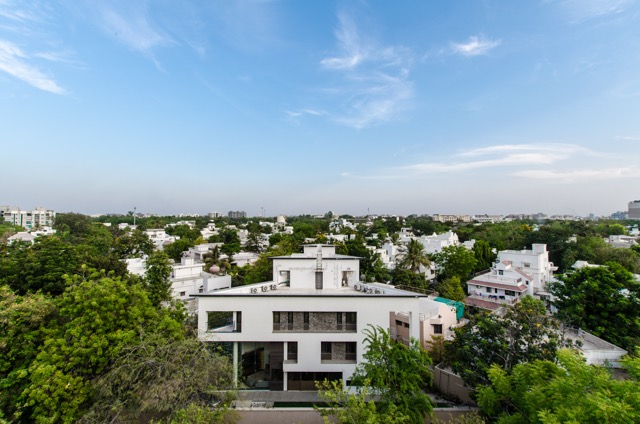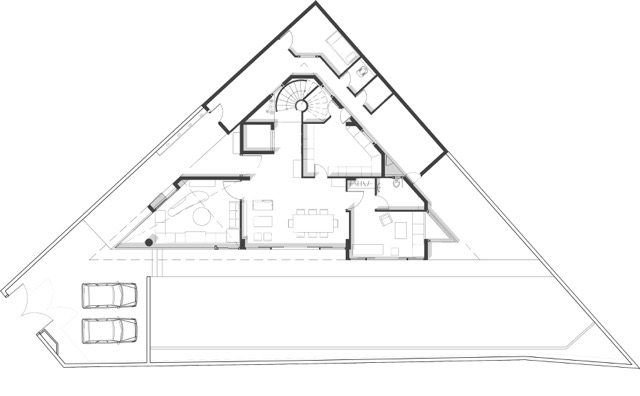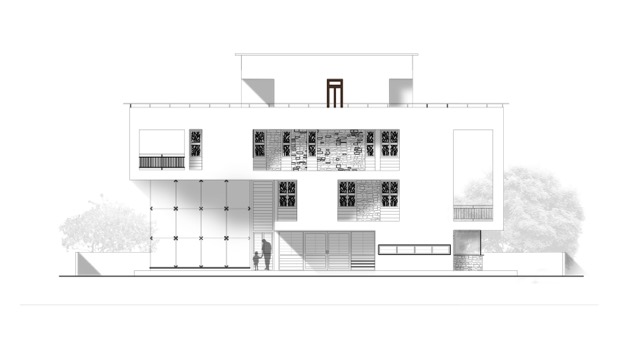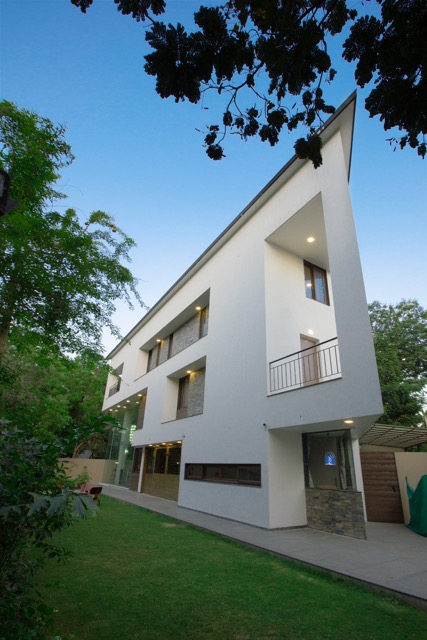Clients: Utpal and Trupti Shah
Text: Prashant Pradhan Architects
Photographs: Pratikruti Photography / Ahemdabad
The Shah residence is a single-family residence located in Ahmedabad, Gujarat. The site is an irregular triangle. The geometry of the site, coupled with Ahmedabad building by-laws, left the design restricted to a very compact area. It was therefore necessary to utilize every part of plot.
Context
Physical: Ahmedabad / Satyagraha Chhavni
The climate of Ahmedabad can be summarized as being ‘hot-dry’ with mild winters and extremely harsh summers and a short monsoon. The architecture of the city is directly affected by the forces of nature. The traditional residential typology of the ‘pols’ addressed the issue by densification of the organic urban structure and creating narrow crevice-like streets and light wells. With the advent of modernity and municipal by-laws prohibiting adjacent and shared walls, the design of the stand-alone residence has had to resort to different means to combat the harsh climate.

Ahmedabad is famous for its architecture and has always been at the cutting edge of the field. Internationally renowned masters such as Louis Kahn, Le Corbusier amongst other great architects have left their mark in having buildings of various scales and contexts – from large institutions such as the IIM to single family dwellings such as the Shodhan Villa. Plotted development and group housing are ubiquitous within the fabric of the city. Satyagraha Chhavni is one such plotted development characterized by lush greenery and attention to open spaces.
Socio cultural: ‘Vaastu’
Most people who purchase plots, prefer ones that are perfect rectangles since they follow ‘vaastu’ principles which, reject all other polygons. The city roads that border such developments define the boundaries and since these roads are part of a larger urban structure, they create odd and irregular geometries in defining the boundaries. Larger plots are designed to be relatively orthogonal but there are usually residual odd-shaped plots that are often quite difficult to sell – usually for residential purposes.
Concept
Site Response: The Flat Iron Building in Manhattan
On seeing the plot, the immediate design response was one that had its roots in the ‘Flat Iron Building’ located between Fifth Avenue and Broadway in Manhattan, New York. Based on a uniform grid comprising of streets in the North-South direction and Avenues in the East-West direction. Broadway – once a Native American path on the North-South Axis, disrupts this orthogonal grid. Since this path does not follow the avenue and street alignment, the planners decided to create public spaces wherever Broadway intersected with the major avenues, thus making it possible to create Union Square, Madison Square; Times Square finally ending at Columbus Circle from where Central Park begins and Broadway aligns with the other avenues. This irregular disruption caused the creation of the flat iron building – that was designed close to the Madison Square Park.

The Flat iron building built in 1902, designed by Chicago based architectural firm Daniel H. Burnham & Co. gets its name based on the unusual plan form. This shape, emerging from the forces of Urban Planning is a monument that records the historical event. It is an extrusion of the resultant residual area left by the collision of rational planning policy with an ancient historical path.
The Shah Residence in Ahmedabad is a product of the same thought process – an extrusion of the residual area left from the interface between the city roads that define the development boundaries and Ahmedabad Municipal by-laws. The plot is adjacent to other plots of the development on two sides and on the third, longer side; it sits alongside an Ahmedabad city road. The height and setbacks of all buildings are dependent of the adjacent road widths and land use zoning policies – therefore, in this case, being located along an important road with substantial width, it was necessary to leave a margin setback of 20’. The other sides required only a 10’ setback.
Orientation
The orientation of the building was based on the site profile available after the extrusion. The longer face of the triangle, one that faced the bounding road happened to be the north side – which coincided with what would be climatically desired. This made it possible for the building to open out on that side and, since the larger setback was necessary in that direction, designing the area as an open lawn and garden became an obvious design decision. All the rooms of the residence opened out onto this lawn with trees and natural foliage and a tall boundary wall that acted as a buffer to diffuse noise from the traffic. On the other two sides, there were large copious trees planted by the neighbours that protected the building from the harsh Ahmedabad sun and also worked out as a pleasant visual – inside looking out.
Smaller openings were provided on the southwestern side in order to amplify airflow based on the prevailing wind direction and maximize cross ventilation. Most of the usable and public areas were located along the longer north façade and, the remaining areas were left to house the utility and services.
Layout: Airplane design
The layout of the triangular shape is derived from the cross section of an airplane. Typically, an airplane is circular and the exterior aerodynamically designed in order to pass smoothly through air currents. The interior however, has to cater to the functional aspects of housing passengers and luggage and to be able to create an insulated and pressurized cabin – so that the exterior conditions are not experience within. It is for this reason that, within the circular section, there is a square / rectangular inner cabin that is carved out and the rest of the area is used as insulation, to carry luggage and for other mechanical installations of the aircraft.
Based on similar design principles, from the triangular mass, the more usable, relatively square and rectangular geometries are carved out – leaving the extreme acute angles to cover ancillary programs such as balconies, staircase and to serve decorative purposes. The rectangular areas in the middle of the triangle are designed to house the living / dining rooms, bedrooms and lounges – all of them have open out into the front lawn on the North-face of the building.
Since the residual site area was quite limited, it was necessary to use every square inch of it. The entire site was considered as part of the design and, the different fields of architecture, interior and landscape flowed into one another. Large openings – fixed and operable, made the blurring of the boundary more seamless. The margin / setback areas were all integrated in the design – serving as utility areas, lawn and gardens, rain water harvesting tank, driveway, covered porch at the entry of the house and service areas.
Extending the Building beyond the Physical Site: The Rietveld Chair
One of the important objectives of the design of the residence was to try and push the extents of the house beyond its physical boundaries. A reference was made to the Rietveld chair, which was designed as an object that was created by imaginary lines of force that would suspend a body in space. The design of this structure would create imaginary lines of sight that would transcend the bounding walls and through its large openings and volumes and experience moving through the spaces created. There were imaginary sight lines that move towards the infinity of the sky.
The Design

The design of the house is functionally segregated into the public and private zones in the different levels. The lowest level houses the drawing room – which is a double volume space that uses the height and the sharp acute angle of the triangle to create a sense of entry into the house. This sets the tone for the rest of the architectural and spatial experience in terms of the materials, textures and visual scenography. The tall space of the drawing room is designed to be the focus of the building – showcasing the clients’ tastes and interests with original artwork, light installations, chandeliers and custom built vitrines. The extended volume opens up the space towards the sky and makes it possible to stargaze right from the comfort of being indoors. The large windows with spider glazing are oriented to face north, thereby enhancing this visual extravaganza while not being unduly affected by the harsh Ahmedabad sun.
The formal entry is located along the North East Wall which is designed to be quite incidental – except for the weatherproof porch that defines it. A large wooden door with a brass handle opens into the foyer of the house. The floor layout continues to the central and widest part of the residence that houses the living and dining areas. This space is bounded by a large sliding door that opens out directly onto the front lawn and flows out onto the lush natural green surface. This is the interactive space of the house and the place where the family will sit together inside, outside or in-between. It is also the geometric center of the residence. A small lounge with an attached bathroom is located in the other end of the triangle.
Sections of the House
The third corner of the triangle is used to house a spiral staircase from the ground floor to the terrace. Adjacent to the staircase is an elevator making the residence completely accessible. Large windows that open out onto grand lush trees make the visual experience quite extraordinary. Butterflies created by Artist Suhani Shah from recycled reinforcement bars adorn the opaque portions of the walls around the staircase. The kitchen and utility areas are located towards the left side of the stairs towards the southwest of the house.
The private areas are located on the floors above. Two childrens’ bedrooms are housed on the first floor. Towards the west is one bedroom, which uses the central orthogonal area inside the room while the extreme acute angle is converted into a double volume balcony. The adjacent room looks down into the double volume of the drawing room. Both the attached bathrooms are accommodated in the odd shaped geometry leaving the bedroom area relatively orthogonal. There is a small common study area that also serves as a foyer for the bedrooms.
The master bedroom is located on the second floor above the drawing room and the acute angle is used as a balcony there. The guest room is located on the opposite side of the triangle. There is a central open area that will be used for gatherings of friends and family.
Sustainability & Energy Efficiency
Passive Practices
– The entire excavation was stored locally and soil was completely reused for fill up and landscaping
– Design with maximum North exposure, large windows letting in light but no direct sunlight
– Windows along the stairs in the South & Southwest allowing breeze to flow through
– Automatic level control for overhead water tank and pressure pumps
– Two separate shafts for water distribution. This reduces run for the hot water transmission.
– No Gypsum/ Plaster of Paris (POP) false ceiling. With adequate planning, structural members, cables for wiring etc. can be incorporated in slabs construction itself. There were a couple of reasons why this ubiquitous material was not chosen for this residence:
– Disposing off statues made out of this material during Ganesh Chaturthi pollutes our water bodies. It breaks down and releases large quantities of Sulfur Dioxide, which is a greenhouse gas.
– The quality of POP available in India causes long-term health problems for the laborers working with POP.
High efficiency and sustainable materials were chosen as much as possible to reduce overall carbon footprint – not just in the building, but also in the usage after construction.
AAC blocks for partitions and exterior walls
– Reduced carbon emission as well as superior heat and sound insulation.
– AAC has been produced for more than 70 years, and it offers several significant advantages over other cement construction materials, one of the most important being its lower environmental impact.
– Improved thermal efficiency reduces the cooling load in building
– Workability allows accurate cutting, which minimizes the generation of solid waste during use
– Resource efficiency gives it lower environmental impact in all phases of its life cycle, from processing of raw materials to the disposal of waste
– Its light weight saves cost & energy in transportation, Labor expenses, increases chances of survival during seismic activity and leads to faster masonry work
Double glazed UPVC windows.
– Excellent heat and sound insulation compared to the traditional windows
– Use of double-glazed UPVC windows. UPVC windows cost roughly the same as regular wood & glass windows that are used throughout India. However, these windows have certain big advantages:
– Much more improved thermal and noise efficiency
– Industrial process as opposed to on-site process yielding much faster turn-around time
– Sufficiently long warranty and maintenance free operation
Rainwater harvesting for drinking
RO and Water filters were discarded opting for natural rainwater for all cooking and drinking needs. The rainwater collected was tested and found to be far superior in the drinkable quality standards laid down by the WHO.




























One Response
A unique triangular house in India- Dhi